🧠 TL;DR: How to Start a Membership Business That Actually Works
If you’re wondering how to start a membership business that generates recurring revenue, delivers real member-only content, and builds an engaged online community, here’s your step-by-step starting point:
- Pick a specific niche and define your ideal member
Don’t try to appeal to everyone. The tighter your focus, the easier it is to attract the right people and build momentum. - Validate your idea before building anything
Use a landing page, a waitlist, or a simple pre-sale offer to test demand. Don’t spend weeks creating content no one asked for. - Choose a platform that supports content, payments, and community
You need a setup that lets you deliver gated content, accept subscriptions, and support interaction — without duct-taping ten tools together. (Hint: Thrive Apprentice makes this easy.) - Price for perceived value — and offer clear tiers
Whether you charge $10 or $100/month, pricing should reflect the transformation you’re offering. Use membership tiers to serve both beginners and power users. - Start with core content — then drip more over time
You don’t need a huge library to start. Launch with your “minimum valuable content,” then use a content drip schedule to keep members coming back. - Focus on onboarding, engagement, and retention
First impressions matter. Build a smooth member onboarding experience, guide people to early wins, and use automation to prevent churn. - Track what matters: churn, CLTV, and conversions
If you’re not tracking metrics like customer lifetime value (CLTV) and conversion rates, you’re flying blind. Use real data to refine and scale.
📌 Bottom line? A digital product membership isn’t just about content — it’s about building a conversion-focused landing page, a strong offer, and a system that keeps delivering value long after the first sale.
Starting a membership business can feel overwhelming. Trust me, I would know.
The stress. The worry. The questions.
Do you build content first? Pick a platform? Set pricing? Launch before you’re ready?
The truth is, you don’t need a huge audience, a complicated setup, or weeks of prep to get started.
You just need a clear plan and a system that focuses on real value and long-term growth.
In this guide, we’ll walk you through what actually works: how to validate your idea, build lean, price with confidence, create member-only content, and retain members with less stress.
If you're serious about building a profitable, scalable membership, this is where to start.
✅ What You Actually Need to Succeed (Before You Google Another Tool)
Before you get caught up in tech tools, pricing tiers, or building your first digital product, take a moment to zoom out.
Every thriving subscription-based business — whether it's a coaching group, content library, or hybrid community — starts with a few key decisions. These decisions shape everything: your message, your recurring revenue potential, your member onboarding, and even your mental load.
Below are the 10 foundational questions that will help you build a membership that feels aligned, delivers real value, and grows sustainably.
If you can answer these clearly and confidently, you're already ahead of 90% of creators still stuck in “maybe later” mode.
Your topic isn’t enough — your offer needs a clear transformation.
Ask yourself: what outcome am I helping people achieve?
Once that’s clear, work backwards to identify the kind of person actively seeking that transformation. This is your true audience.
Use the purpose → audience → value cascade: start with your core purpose, map it to the specific people who need it, and define what they’ll gain by becoming members. Before you build anything, validate demand with a small test offer, poll, or direct outreach.
People don’t stay for content alone.
They stay for clarity, progress, and connection. Your unique value comes from delivering something they can’t get anywhere else — whether that’s exclusive insights, a tight-knit community, live access, or hands-on transformation.
You need a compelling reason for someone to join, but also a stronger reason for them to stay.
You want a platform that supports content delivery, payment processing, member management, and future growth — without locking you into rigid templates or sky-high costs.
Whether you use WordPress or a hosted option, prioritize flexibility, ease of use, and long-term control. A good platform should simplify your workflow and let you focus on what matters: your members.
Pricing is positioning. Set your price based on the value of the outcome you help deliver, not how much content is inside.
A low price can sometimes signal low value. Consider tiered plans to serve different types of members, or use anchor pricing to highlight your best offer. Freemium trials or founding member rates can help build early momentum, but revisit your pricing as your offer matures.
Start with what you already have. You don’t need a massive content library to begin — just a strong foundation that solves a real problem.
Build a simple starter library and plan a drip schedule that introduces new material steadily. Think in terms of member journeys: what does someone need to experience, learn, or achieve in their first 30, 60, or 90 days?
Community is what makes memberships sticky.
Don’t rely on passive forums — facilitate real interaction. Let members contribute ideas, share wins, and support each other. Introduce rituals like weekly check-ins, challenges, live calls, or member spotlights to build connection and belonging. A strong community increases retention, referrals, and the overall value of your offer.
Your marketing should speak to outcomes, not features. People want transformation, clarity, and progress. Use stories, results, and testimonials to show what’s possible. Start with warm audiences: your email list, network, or blog readers.
Then build a content-driven flywheel: evergreen blog posts, referral incentives, guest features, and social proof. Marketing doesn’t need to be complicated — it needs to be consistent.
Retention starts the moment someone joins. Build a friction-free onboarding experience that guides new members to quick wins.
Set engagement triggers that help you spot drop-off early — for example, sending a helpful tip if someone hasn’t logged in within a week. When people cancel, ask why. Exit surveys reveal what your onboarding, content, or community might be missing.
In the beginning, plan to spend at least 10 hours a week. You’ll be building, refining, supporting, and engaging.
Your credibility matters, but it doesn’t have to be perfect. You can build trust by showing up, being consistent, and solving a real problem. As you grow, be ready to delegate operations so you can focus on strategy and member results.
Track metrics that actually move the needle: churn rate, customer lifetime value (CLTV), cost to acquire a customer (CAC), and engagement.
Review these regularly and use them to inform decisions around pricing, retention, and content delivery. Growth isn’t about doing more — it’s about optimizing what already works and doubling down on what your members value most.
🚨Most Membership Businesses Are Built on Hope, Not Strategy
Search “how to start a membership business” and you’ll get flooded with checklists, tool roundups, and platform breakdowns. But here’s what many people actually do:
They build a beautiful, feature-packed website.
They spend weeks (or months) recording videos, creating downloads, and polishing the perfect course.
They launch... and hear nothing but silence.
So they lower their prices, hoping affordability will fix it.
Then they get caught in the cycle — constantly replacing members who quietly cancel.
It’s discouraging. But it’s not uncommon.
The truth? Most membership site ideas fail not because of bad content or weak tools — but because they were built without a clear plan. Without strategy, it’s just guesswork.
Here’s where it usually breaks down:
- No niche → The offer is too broad. It doesn’t speak clearly to anyone, so no one feels like it’s “for them.”
- No validation → Content is created in isolation, without real-world proof there’s demand.
- No community → Without relational depth or engagement, it becomes a transactional site — not a place members want to return to.
- No system → When there’s no structure, automation, or onboarding flow, growth becomes reactive and overwhelming.
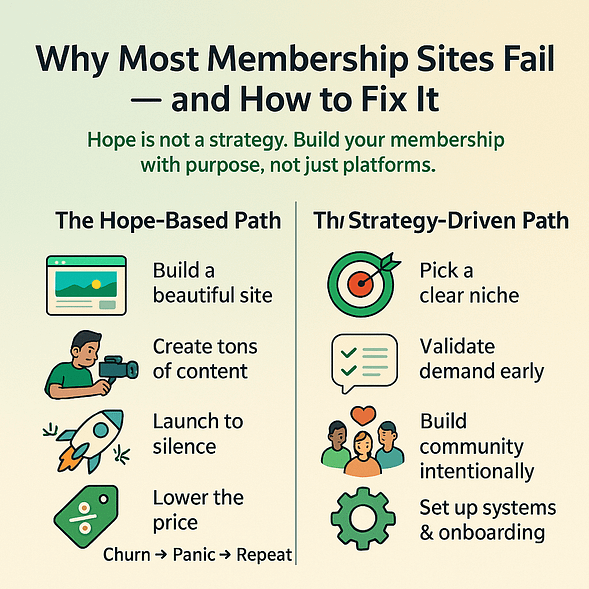
That’s how creators burn out — and why churn reduction becomes nearly impossible.
It’s not about launching faster. It’s about launching smarter.
One that starts with a real strategy, focuses on value, and builds an online community people want to be part of for the long haul.
🔥What Happens If You Keep Building Blind
You’ve done the hard part: you committed to launching a membership. Maybe you built the site. Created hours of content. Designed the perfect dashboard.
But still… barely anyone joins. Or worse, they join and quietly leave.
And suddenly you’re dealing with:
- Months of work and zero return — no sales, no growth, no feedback
- Burnout from constantly trying to prove your value to an invisible audience
- Tech stack debt — too many tools duct-taped together with no clear ROI
- Pressure to always sell — because retention is low and new members keep dropping off
- Doubt creeping in — “What if I’m just not cut out for this?”
It’s not just a business problem. It starts to weigh on your creativity, your motivation, your confidence. The mental fatigue of doing “all the right things” and still seeing no results is real and common.
But it’s not you. It’s the lack of strategy. Once you shift from reactive to intentional, everything changes, including your results.
🔧 How to Start a Membership Business: Step-by-Step Breakdown That Actually Works
If you’ve made it this far, you’re not just casually exploring the idea — you’re serious about launching a membership that works. You want a step-by-step path that’s clear, actionable, and built on real strategy — not guesswork.
In this section:
Choose Your Membership Model Like a Strategist
If you want your membership business to succeed, you need to do more than “pick a topic.” You need a clear, strategic model that aligns with your audience, your strengths, and the way people prefer to learn or connect.
This starts with niching down — not just by category, but by transformation, format, and focus. Go at least three layers deep. For example, instead of “career coaching,” think “interview prep for mid-career professionals in tech.”
From there, choose the membership model that best fits how you want to serve. The most common (and profitable) structures include:
🧠 1. Content-Driven Memberships
This is what most people think of when they hear “membership site”: a structured library of member-only content that subscribers can access on demand. Think of it like a “Netflix for your niche,” offering video courses, templates, tutorials, audio trainings, or written resources.
Why it works: It turns your knowledge into a scalable digital product membership. Once created, content can serve hundreds (or thousands) of members without extra effort — which is great for long-term sustainability.
Best for:
- Course creators and educators
- Entrepreneurs with an archive of resources or workshops
- Businesses with existing digital products they can bundle
Key success tips:
- Organize content by clear transformation stages — not just topic
- Use a content drip schedule to pace new releases and encourage retention
- Add progress tracking, completion badges, or milestone incentives to boost engagement
🧩 Pro tip: Don’t overwhelm new members. A massive content dump can make people feel lost — especially if they don’t know where to start. Curate their journey.
💡 Need help figuring out what kind of digital content to include?
If you're not sure what to build, or you're sitting on years of content with no idea how to package it, check out our detailed guide:
👉 33 Innovative Digital Product Ideas for Creative Entrepreneurs You'll find actionable inspiration for templates, tutorials, downloads, and toolkits — even if you're starting from scratch.
🗣️ 2. Community-Led Memberships
In a community-led model, content may exist, but the online community is the main reason people join (and stay). Members gain access to a private space — a forum, Slack group, Discord server, Circle hub, or BuddyBoss-powered site — where they can connect, collaborate, and grow together.
Why it works: Humans crave connection. In certain niches, access to like-minded peers, direct feedback, and shared wins can be far more valuable than any video library.
Best for:
- Coaching-based businesses
- Professional networks or niche communities
- Founders who are natural facilitators
Key success tips:
- Design regular community “rituals”: weekly prompts, live calls, member spotlights
- Hire or appoint a community manager once it grows
- Create clear rules and a welcoming culture from the start
💬 Engagement isn’t automatic — it’s built. Set expectations for interaction, and lead by example. The more you show up, the more members will too.
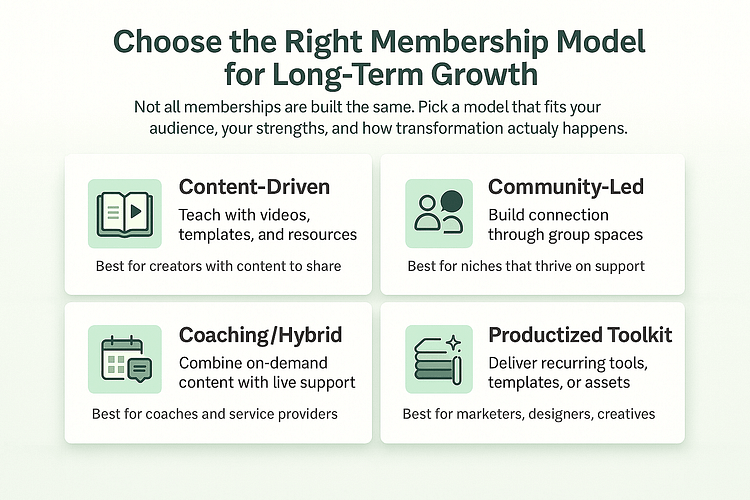
🎯 3. Coaching or Hybrid Memberships
This model combines content delivery with live interaction — often via coaching calls, live Q&As, office hours, or even private feedback sessions. It’s ideal for experts who want to scale their time without losing the human touch.
You can structure tiers, offering recorded content at a base level and adding personal access or events at higher tiers.
Why it works: Members feel seen and supported. Live support creates accountability, trust, and better outcomes — which drives longer retention.
Best for:
- Service providers shifting to group delivery
- Coaches with a proven method or framework
- Experts with a strong personal brand
Key success tips:
- Be clear on what is (and isn’t) included — especially with live access
- Build structured onboarding to orient new members quickly
- Schedule and batch your coaching content to avoid burnout
🛠️ Hybrid models are powerful but require boundaries. Don’t promise unlimited access if it’s not sustainable — build in structure from day one.
🧪 4. Productized or Toolkit Memberships
Instead of training or community, this model gives members recurring access to tools and resources they can use right away — like templates, swipe files, spreadsheets, design kits, stock assets, or plug-and-play frameworks.
It’s a “done-for-you” approach that delivers speed and convenience.
Why it works: Time is money. Many professionals would rather pay for ready-made assets than create from scratch. This model solves that need directly and can be incredibly scalable.
Best for:
- Designers, copywriters, and marketers
- Agencies with reusable deliverables
- Creators who already sell templates or resource packs
Key success tips:
- Keep your resources organized and easy to access
- Update regularly to maintain perceived value
- Bundle related assets to increase retention and usage
📦 Think of it like a subscription box — members stick around when they look forward to what’s coming next.
So, Which Membership Model Should You Choose?
There’s no perfect choice — only the best fit for your business, your personality, and your audience’s needs.
If you’re not sure, start with the model that’s easiest for you to deliver right now, and iterate from there. Many of the most successful membership sites evolve into hybrids over time as the business (and audience) grows.
Next up: we’ll walk through how to validate your membership idea before you build, so you don’t waste time on the wrong offer.
Validate Before You Build
One of the most common mistakes people make when starting a membership business is building everything before they know if anyone actually wants it.
Before you create content, design a members-only dashboard, or plan your community rituals — validate the demand.
Start with a simple version of your offer. Can you pre-sell it? Can you open a paid waitlist? Can you run a live workshop or cohort version first, then turn that into the membership later?
This isn’t just about testing interest — it’s about testing your messaging, your niche, and your offer positioning. That’s what gives you the confidence to move forward (or pivot early).
A few ways to validate before you build:
- Create a landing page that clearly describes your offer and who it’s for
- Drive traffic from your email list, social media, or a soft launch announcement
- Collect signups for a paid waitlist or early access beta
- Ask follow-up questions to understand objections or hesitation

You don’t need a full-blown sales funnel to do this. A single page with a strong headline, clear promise, and call-to-action is often enough. If people buy or sign up, you’ve got validation. If they don’t, you tweak and test again.
Remember: recurring revenue only happens when there’s recurring demand. So validate your idea early — and make sure your membership launch funnel starts with real signals, not assumptions.
Pick the Right Platform (and Avoid Tech Stack Chaos)
Your membership platform isn’t just a place to upload content — it’s the engine behind how you deliver value, protect your time, and create an experience your members want to return to. Pick the wrong one, and you could find yourself tangled in tech issues, spending more than you planned, and constantly fixing things that should just work.
So before you commit, ask yourself:
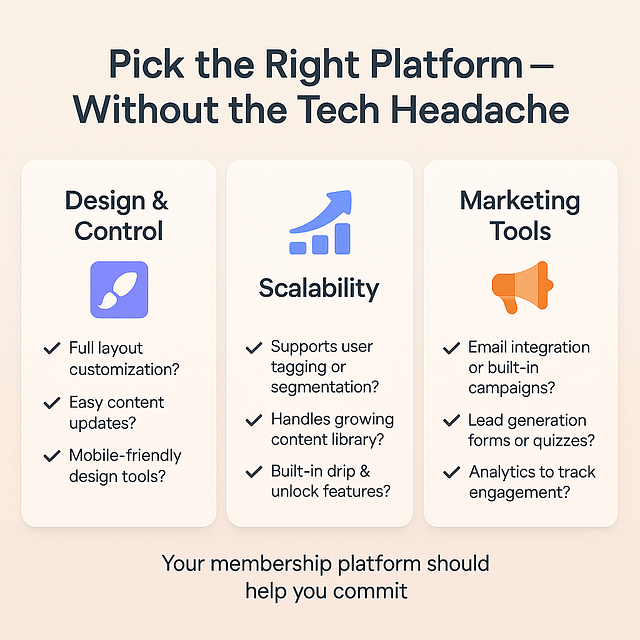
If you’re building on WordPress (which gives you the most long-term flexibility), here are the best membership plugins worth considering:
- Thrive Apprentice – My personal pick for most use cases. It’s powerful, intuitive, and built for conversion — combining course and membership delivery, full design control, and tight integration with tools like Thrive Architect and Thrive Leads. Ideal for creators who want a lean, high-performing setup.
- MemberPress – Another solid choice if you want deep access control and reliable reporting. Works well out of the box, though you may want to pair it with additional plugins for customization or marketing.
- Wishlist Member – Flexible and developer-friendly, especially for complex access rules. Can be powerful but may feel clunky for beginners.
Running a community alongside your content? Consider adding bbPress or BuddyBoss for discussion forums, member profiles, and deeper engagement features.
Bottom line: start lean, but think long-term. The right platform should let you move fast, control your gated content, and build a member experience that doesn’t rely on duct tape.
Price for Value, Not Panic
Pricing is one of the most anxiety-inducing decisions when starting a membership business — but it doesn’t have to be. Your goal isn’t to be the cheapest. It’s to match the value of your transformation to the right pricing structure.
There are two main pricing models to consider:
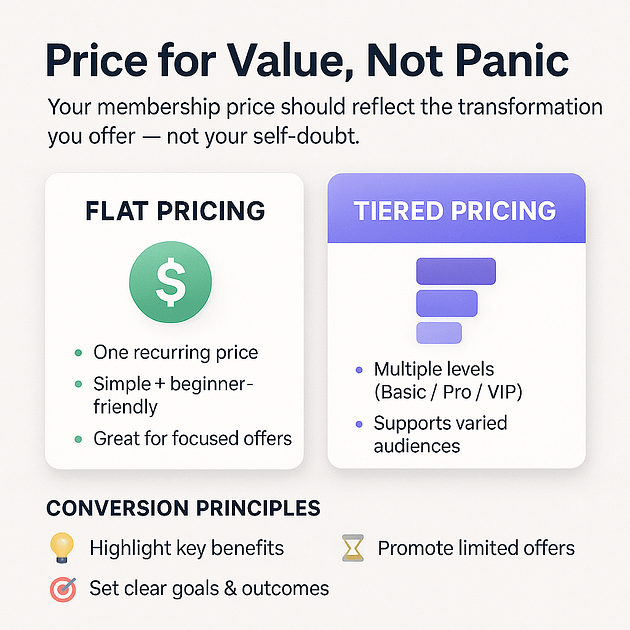
If you’re unsure where to start, begin with one clear price — then test tiered options later as you grow.
What matters most is how you frame your offer. Here are a few pricing principles that increase conversions:
Your pricing page should be clear, benefit-driven, and easy to skim. Use contrast, testimonials, and feature comparisons to help people self-select the right tier.
If you’re using Thrive Architect, you can quickly build high-converting pricing pages. Pair it with Thrive Ultimatum for smart scarcity (like countdown timers or enrollment deadlines) that increases perceived value without being pushy.
Remember: people don’t cancel memberships that feel worth it. So price for value — not panic.
Want to avoid the most common pricing mistakes?
Don’t leave money (or members) on the table. If you're not sure whether to charge $15/month or $150/year — or whether to use tiers at all — this guide is for you:
👉 10 Pricing Mistakes You Must Avoid in Your Online Business
Inside, we break down real-world examples, psychological insights, and actionable strategies to help you price with confidence from day one.
Only Create the Content You Need to Start
It’s easy to fall into the trap of thinking your membership needs to be packed with content from day one. In reality, more content ≠ more value — especially if no one’s joined yet.
Before you spend weeks recording videos or building full libraries, do this first:
- Audit what you already have — Blog posts, checklists, PDFs, presentations, or client training material can often be repurposed into your first member-only content.
- Plan a 30-day runway — Outline what your members will need in their first month to stay engaged, get results, and feel momentum. That might include a welcome video, a short course, and weekly micro-wins — not a 12-module program.
- Think in transformations, not quantity — Ask: what’s the first meaningful win your member can achieve? Build toward that.
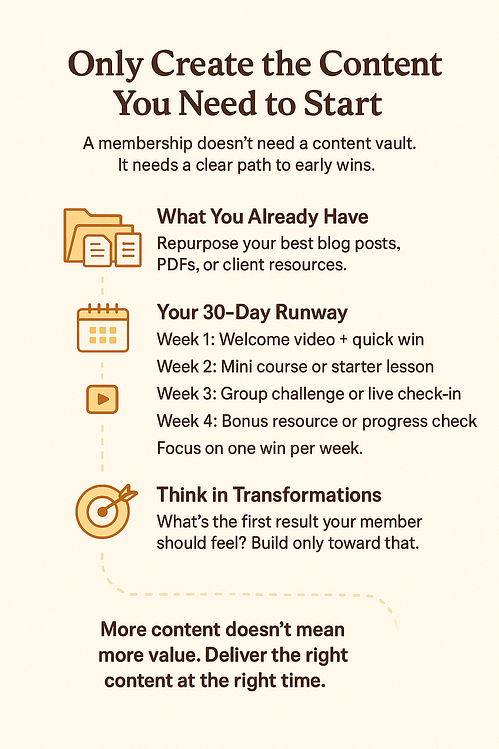
A simple content drip schedule is often more effective than a full content dump. Dripping content weekly or bi-weekly gives members time to digest and apply — and gives you space to keep creating without burning out.
If you're using Thrive Apprentice, you can easily schedule content unlocks, set access rules, and create a structured, scalable experience.
You don’t need a vault. You need a roadmap that delivers value — one step at a time.
Launch and Grow With a Conversion Funnel
Your membership launch isn’t just a moment — it’s a system. A smart digital product funnel (for your membership program) creates awareness, builds desire, and guides people through the decision to join. And it doesn’t need to be complicated to work.
Start with a founding member campaign — a time-limited offer that invites your early audience to join at a special price or with extra perks. This does two things:
- Validates your offer with real buyers
- Gives you social proof and feedback before a wider launch
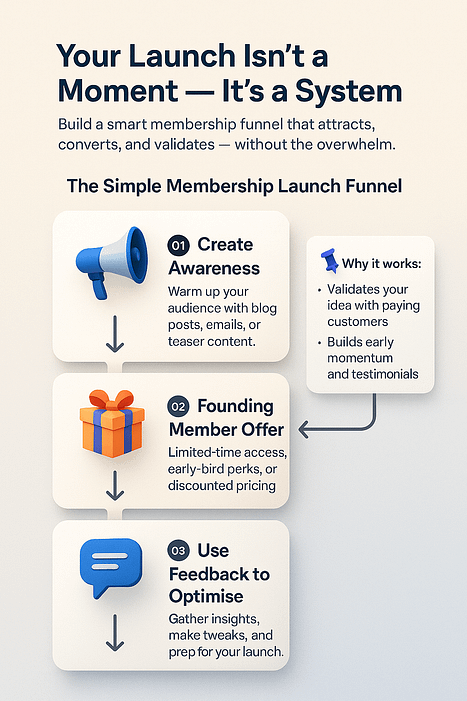
Use a conversion-focused landing page to sell the transformation, not the toolset. Focus on outcomes, clarity, and trust signals — not just a list of content or features.
Then connect it all with simple automation:
Need help building a landing page that actually converts?
Most membership creators overthink the design and overlook the strategy. A good landing page isn’t about looking fancy — it’s about removing friction and making your offer irresistible.
👉 Check out our Landing Page Checklist — it walks you through the exact structure, copy elements, and design best practices to turn curious visitors into committed members.
As soon as your first members are in, start gathering testimonials. Don’t wait until they’ve finished the full experience — capture those early wins. Tools like Thrive Ovation can help you display them strategically across your site and funnel.
The goal? Launch fast, learn fast, and let your funnel evolve based on real engagement.
Engage Members and Reduce Churn
Getting members through the door is only half the battle. The real challenge? Keeping them engaged so they stick around, stay active, and keep paying.
The key to churn reduction is to think about the entire member journey — especially the first 30 days. That’s when most cancellations happen.
Start with strong member onboarding. Don’t just send a login email and hope they explore. Instead:
- Guide them through a clear “start here” process
- Set a simple milestone for week one (like completing their first module or joining the community)
- Celebrate quick wins early and visibly

Once they’re in, use re-engagement triggers to prevent drop-off. For example:
Your online community is a powerful tool for long-term retention. Use rituals that encourage participation and belonging:
People leave when they feel forgotten. But when members feel seen, supported, and part of something — they stay.
Grow Your Revenue the Smart Way
Once your membership is up and running, the next step isn’t just more members — it’s more value per member. That’s how you build a sustainable online business model without burning out trying to sell 24/7.
Start by increasing your customer lifetime value (CLTV) — the total revenue a member brings in over the course of their subscription. There are a few smart ways to do this:
- Add premium tiers: Offer more access, coaching, or done-for-you support for your most committed members. Even a small percentage upgrading can double your revenue.
- Create targeted upsells: Think mini-courses, templates, audits, or add-on services that align with your core offer. (Learn more about upselling and cross-selling here)
- Encourage referrals: Build in simple incentives for your members to share — like free access, discounts, or exclusive bonuses. Word-of-mouth is powerful in trust-based communities.
- Use partner promotions: Collaborate with aligned creators or tools your audience already uses. It’s a win-win if the offer provides real value.
Finally, track your numbers. Your CAC:CLTV ratio (customer acquisition cost vs. lifetime value) gives you a real-world look at profitability. If you’re spending $50 to acquire a member who stays for $300 of value, you’re in a good spot. If it’s the other way around, it’s time to adjust.
Revenue growth isn’t just about “more.” It’s about smarter. The better you understand your members, the more ways you can serve — and scale.
🎁 Bonus Section: The Thrive Stack That Powers It All
If you want to build a membership site that not only works — but converts, grows, and feels like you — the right toolkit makes all the difference.
Here’s the Thrive Stack I use and recommend to bring it all together:
- Thrive Apprentice
Your membership HQ. Easily drip content, protect member-only access, and build scalable digital products — without duct-taping plugins together. - Thrive Architect
Design beautiful, conversion-focused landing pages, sales pages, and pricing layouts with drag-and-drop ease. No coding, no stress. - Thrive Leads
Grow your email list before (and after) launch with high-performing opt-in forms, ribbons, popups, and targeted offers. - Thrive Quiz Builder
Segment your audience with personality quizzes, assessments, or onboarding flows — and personalize the experience from the first click.
Each tool is built for WordPress, deeply integrated with the others, and optimized for speed and simplicity. Whether you're launching your first membership or scaling your tenth, this stack gives you the power to do it your way — and do it well.
❓ FAQ: Starting and Growing a Membership Site
Yes — but clarity matters more than size. If you can define a specific transformation and speak directly to the right people, you can build from scratch. Start with warm outreach, referrals, and content that positions your expertise. You don’t need thousands of followers — just a real problem you can solve.
Just enough to deliver on your core promise. One or two high-impact modules or a short starter series is enough to begin. You can always add a content drip schedule as you go. What matters most is momentum, not volume.
Thrive Apprentice is my top pick — it gives you full control over content delivery, member access, and conversion-focused design, without the bloat or monthly fees of all-in-one platforms. MemberPress is another solid option if you need deep integration with payment systems or BuddyBoss.
Nail your onboarding. Guide members to a fast win, create a strong welcome sequence, and give them a reason to come back (like a challenge, live call, or reward). Early engagement is the biggest predictor of long-term retention.
🏁 Conclusion: Don’t Build Another Content Hub. Build a Conversion Engine.
Most membership sites don’t fail because of bad content.
They fail because they were never designed to convert, engage, or grow from day one.
A successful membership business is built with intention. It starts with a clear transformation. It’s backed by strategy, not guesswork. And it’s sustained by tools that help you scale without burning out.
So before you invest hours creating content no one’s asked for, or stitching together a tech stack you’ll later regret, take a step back and remember:
✅ Choose a focused, transformation-driven model — not just a niche, but a specific outcome people will pay for
✅ Validate before you build — pre-sell, run waitlists, and use simple landing pages to gauge real interest
✅ Price for value and retention — not fear
✅ Create only what your members need to succeed in their first 30 days
✅ Build a funnel that sells with clarity — not pressure
✅ Focus on member engagement and community, because that’s where long-term revenue comes from
✅ Track key metrics like CLTV and churn — and let the data drive your growth
With the right approach — and the right tools — your membership can become a true conversion engine: something that not only earns recurring revenue, but builds real relationships and delivers consistent value.
✨ Ready to build a membership site that sells itself and scales with you?
Try Thrive Suite and launch with confidence — without getting lost in tech or content overwhelm.


